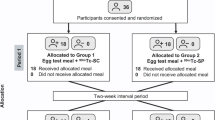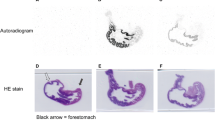Abstract
The aim of this study was to assess the gastric emptying rate of two antacids using an scintigraphic technique and simultaneous monitoring of gastric pH in 16 healthy male volunteers. Ten ml of Talcid (hydrotalcite 1 g) and Maalox (Mg-Al-hydroxide), with a similar neutralization capacity, were labelled with technetium-99m using a pyrophosphate bridge. Labelled antacids were given on separate days (within 2 weeks), 1 h after a standard meal. Intragastric pH was measured for at least 4 h, using ambulatory pH-metry with a dual-crystant antimony catheter. Continuous monitoring was started 1 h prior to the meal (baseline) and lasted 3 h (post-prandial, post-antacid and final periods). The antacid capacity of labelled and unlabelled antacids was similar. The mean percentages of antacids retained in the stomach fitted a linear model. The mean half-emptying time of Talcid was 63.9±27.9 min, while that of Maalox was 57.3±23.9 min (P=NS). The recordings of gastric pH (mean values of pH for each period) showed a similar profile for both antacids. The mean pH (Maalox vs Talcid) was 1.69 vs 2.07 in the baseline period, 1.95 vs 1.93 in the post-prandial period, 1.79 vs 1.15 in the post-antacid period (P=NS) and 0.4 vs 0.52 in the final period (P<0.05 vs prior periods). In conclusion, the gastric emptying of Talcid and Maalox was similar and pH profiles were parallel and remained unchanged for the two antacids within the first hour of intake. A significant decrease in pH was observed 1 h after intake of the antacids, suggesting a possible rebound effect.
Similar content being viewed by others
References
Peterson WL, Sturdevant RA, Frankl HD, Richardson CT, Isenberg JI, Elashoff JD. Healing of duodenal ulcer with an antacid regimen.N Engl J Med 1977; 297: 341–345.
Englert E Jr, Freston JW, Graham DY, etal. Cimetidine, antacid and hospitalization in the treatment of benign gastric ulcer. A multicentre double-blind study.Gastroenterology 1978; 74: 416–425.
Ippoliti AF, Sturdevant RA, Isenberg JL, etal. Cimetidine vesus intensive antacid therapy for duodenal ulcer: a multicenter trial.Gastroenterology 1978; 74: 393–395.
Fedeli G, Anti M, Rapaccini GL, de Vitis I, Cicello IM. A controlled study comparing cimetidine treatment to an intensive regimen in the therapy of uncomplicated duodenal ulcer.Dig Dis Sci 1979; 24: 758–762.
Bianchi Porto G, Parente F, Lazzaroni M, Barni S, Panza E. Medium-dose antacids vesus cimetidine in the short term treatment of duodenal ulcer.J Clin Gastroenterol 1986; 8: 141–145.
Becker U, Lindorff K, Andersen C, Ranlov PJ. Antacid treatment of duodenal ulcer.Acta Ned Scand 1987, 221: 95–101.
Rydning A, Weberg R, Lange O, Berstad A. Healing of benign gastric ulcer with low-dose antacids and fiber diet.Gastroenterology 1986; 91: 55–61.
Isenberg JL, Peterson WL, Elashoff JD, etal. Healing of benign gastric ulcer with low-dose antacid or cimetidine: a double-blind randomized, placebo-controlled trial.N Engl J Med 1983; 308: 1319–1324.
Nauert C, Caspary WE Duodenal ulcer therapy with low-dose antacids: a multicenter trial.J Clin Gastroenterol 1991; 13 Suppl l: 5149–5154.
Kumar N, Vij JC, Karol A, Anaud BS. Controlled therapeutic trial to determine the optimum dose of antacids in duodenal ulcer.Gut 1984: 25: 1199–1202.
Lux G, Hentschel H, Rohner HG, etal. Treatment of duodenal ulcer with low-dose antacids.Scand J Gastroenterol 1986; 21: 1063–1068.
Weberg R, Aubert E, Dahlberg O, Dybdahl J, Ellekjaer E, Farup PG. Low-dose antacid or cimetidine for duodenal ulcer?Gastroenterology 1988; 95: 1465–1469.
Zaterka S, Cordeiro F, Lyra LG, etal. Very low-dose antacid in treatment of duodenal ulcer: comparison with cimetidine.Dig Dis Sci 1991; 36: 1377–1383.
Holtermüller KH, Liszkay M, Bernard I, Haase W and Talcivent Study Group. Therapy of benign gastric ulcer with low dose antacid hydrotalcite vs ranitidine. Results of a doubleblind, randomized multicenter trial.Z Gstroenterol 1992; 30: 717–721.
Preclik G, Stange EE, Gerber K, Fetzer G, Horn H, Ditschuneit H. Stimulation of mucosal prostaglandin synthesis in human stomach and duodenum by antacid treatment.Gut 1989; 30: 148–151.
Preclik G, Stange EE, Gerber K, Fetzer G, Horn H, Schneider A, Ditschuneit H. Effect of antacid treatment on endogenous prostaglandin synthesis in human antral and duodenal mocosa.Dig Dis Sci 1989; 34: 1860–1864.
omschke W, Hagel J, Ruppin H, Kaduk B. Antacids and gastric mucosal protection.Scand J Gastroenterol 1986; 21 Suppl 125: 144–149.
Hollander D, Tarnawski A. Are antacids cytoprotective?Gut 1989; 30: 145–147.
Sewing KFR. Efficacy of low-dose antacids in the treatment of peptic ulcers: pharmacological explanation?J Clin Gastroenterol 1991; 13 Suppl 1: S134-S138.
Weberg R, Berstad K, Berstad A. Acte effects of antacids on gastric juice components in duodenal ulcer patients.Eur J Clin Invest 1990; 20: 511–515.
Konturek SJ, Brzozowski T, Drozdowicz D, Dembinski A, Nauert C. Healing of chronic gastroduodenal ulcerations by antacids. Role of Prostaglandins and epidermal growth factor.Dig Dis Sci 1990; 35: 1121–1129.
Halter F. Antacids.Eur J Gastroenterol Hepatol 1992; 4: 947–983.
Tarnawski A, Stachura J, Krause WJ, Douglass T, Gergely H. Quality of gastric ulcer healing: a new emerging concept.J Clin Gastroenterol 1991; 13 Suppl 1: S42-S47.
Holtermüller KH, Köning U. Safety of antacids. In: Bianchi Porto G, Richardson CT, eds.Antacids in peptic ulcer disease. State of the art. New York: Raven Press; 1988: 41–52.
Roca M, Carrio I, Monés J, Mora J, Estorch M, BernA L. Labelling procedure of antacid preparations using99m-Tc-pyro-phosphate.Int J Pharmacol 1991; 69: 189–192.
Monés J, Carrio I, Roca M, etal. Gastric emptying of two radiolabelled antacids.Gut 1991; 32: 147–150.
Weberg R, Berstad A, Osnes M. Comparison of low-dose antacids, cimetidine, and placebo on 24-hour intragastric acidity in healthy volunteers.Dig Dis Sci 1992; 37: 1810–1814.
Calabuig R, Carrio I, Monés J, Puig J, Vilardell F. Gastric emptying after truncal vagotomy and pyloroplasty.Scand J Gastroenterol 1988; 23: 659–664.
Carrio I, Estorch M, Serra-Grima R, etal. Gastric emptying in marathon runners.Gut 1989; 30: 502–503.
Monés J, Carrio I, Calabuig R, etal. Influence of the menstrual cycle and menopause on the gastric emptying rate of solids in female volunteers.Eur J Nucl Med 1993; 20: 600–602.
Bennet CE, Hardy JG, Wilson CG. The influence of posture on the gastric emptying of antacids.Int J Pharm 1984; 21: 341–347.
May HA, Wilson CG, Hardy JG. Monitoring radiolabelled antacid preparations in the stomach.Int J Pharmacol 1984: 19: 169–176.
Tarnawsky A, Halter F, Schmassmann A, Vatier J, Garner A. Experimental models for the assessment of antacid action on gastrointestinal mucosa and ulcer healing.Eur J Gastroenterol Hepatol 1992; 4: 966–976.
Andersen J, Naestal J, Strom M. Identical 24-hour gastric pH profiles when using intragastric antimony or glass electrodes or aspirated gastric juice.Scand J Gastroenterol 1988; 23: 375–379.
Savarino V, Mela GS, Zentillin P, et al. Gastric aspiration versus antimony and glass electrodes. A simultaneous cfomparative in vitro study.Scand J Gastroenterol 1989; 24: 434–43
Author information
Authors and Affiliations
Rights and permissions
About this article
Cite this article
Monés, J., Carrio, I., Sainz, S. et al. Gastric emptying of two radiolabelled antacids with simultaneous monitoring of gastric pH. Eur J Nucl Med 22, 1123–1128 (1995). https://doi.org/10.1007/BF00800593
Received:
Revised:
Issue Date:
DOI: https://doi.org/10.1007/BF00800593




